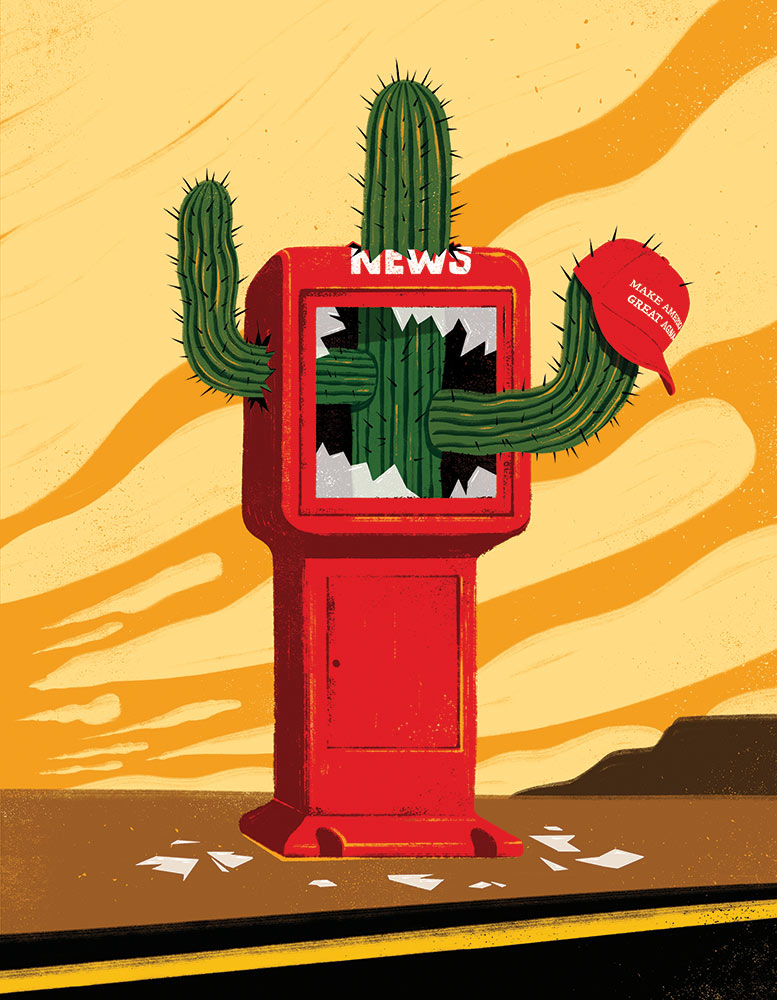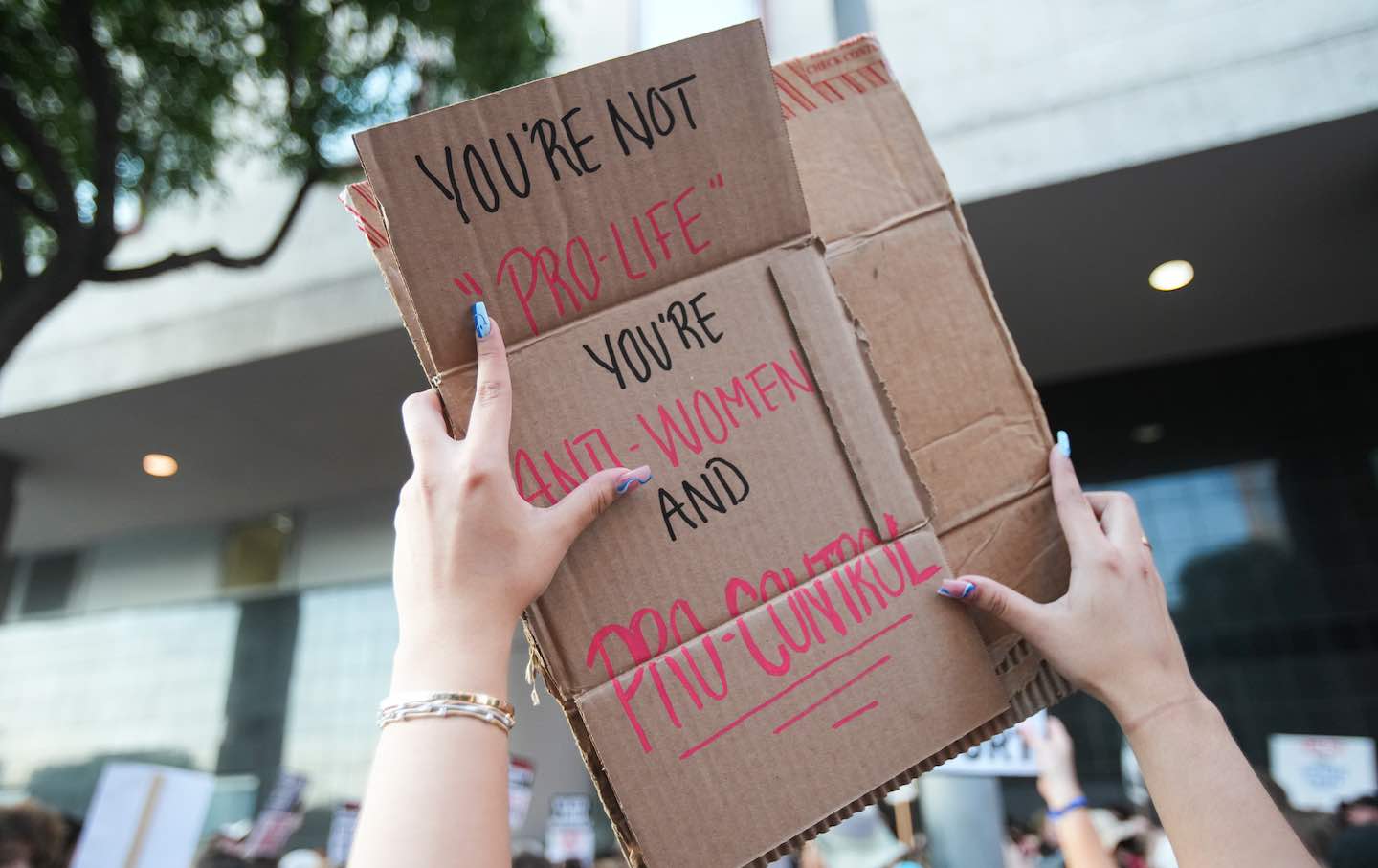Local News Has Been Destroyed. Here’s How We Can Revive It.
A plan to build back better.

Over the past decade, the most useful construct for explaining the crisis that is playing out at the intersection of American media and democracy has been that of the “news desert.” Popularized through the groundbreaking work of researchers like those at the University of North Carolina’s Center for Innovation and Sustainability in Local Media, the idea was instantly recognizable to people living in small towns like the one where I grew up, in rural southeastern Wisconsin: As old-media outlets collapsed and new media failed to fill the void, news in vast stretches of the United States was going uncovered. Over time, the definition was expanded to recognize the decline of newspapers and other forms of media in metropolitan areas, where—just as in rural America—people were being deprived of “the sort of credible and comprehensive news and information that feeds democracy at the grassroots level,” the center warns.
The “news desert” framing has proved to be enormously valuable, not just for journalists and media reform activists but also for political writers trying to explain why former president Donald Trump—despite 91 criminal charges and ever more fascistic rhetoric—currently leads most recent 2024 general election polls. When people get all their information from Fox News, right-wing talk radio, and Elon Musk’s X—with no tempering by a local outlet that offers some variety of reporting and opinion—is it any wonder that Trump’s strongest support has come from news deserts?
Yet, despite all that it has added to the national conversation, the concept of the news desert as it’s currently understood is due for retirement. That’s because the idea can no longer adequately describe what has happened in the United States. The term “news desert” implies that, somewhere, there is a news oasis—some pocket of the country where local journalism is thriving. But while some places are better off than others, the process of desertification has spread across the whole country. This is not an isolated, or an isolatable, phenomenon. America has become a coast-to-coast news desert.
It is neither wise nor accurate to think of the death of local news as a phenomenon associated with the most neglected corners of America, be they rural or urban. “People think news deserts are only in flyover country,” says Samuel Freedman, a veteran newspaper reporter and former New York Times columnist. “Local news, local journalism, is disappearing everywhere.”
The crisis is becoming every bit as real in prosperous urban centers as it is in the abandoned factory towns of the Rust Belt or the dusty county seats of the Dakotas. Just ask Congressman Greg Casar, a Texas Democrat who represents two of the most dynamic metropolitan areas in the United States: Austin and San Antonio.
In 2014, when he was elected to the Austin City Council, Casar found a robust media spotlight trained on him. “We usually had two people from the Statesman at most council meetings,” he says, referring to the Austin American-Statesman, a traditional daily print and digital newspaper. “We usually had a reporter from the Chronicle, our alternative weekly, and another from NPR, some television people. It was a crowd.” But that was then. “By the time I was leaving [in 2022], there were a lot of meetings where the media table was empty,” Casar tells me.
Casar talks about the decay of local media in Austin, a university town and state capital at the heart of one of America’s most rapidly growing regions, with the same sense of loss as the residents of areas such as Hemphill County, Tex., where the local weekly newspaper stopped publishing in March, or Union Grove, Wis., where I grew up and started working for the now-defunct Union Grove Sun. “It’s one of the saddest things I’ve seen in my time in politics,” Casar says of the hollowing out of journalism in Austin. “It’s a huge issue for this city and, I’d say, for the whole country.”
The great mesh of local media that underpinned our civic life—made up of thousands of newsrooms that tried, however imperfectly, however insufficiently, to tell the story of the United States—has been torn so violently that it no longer functions. Our democratic safety net, which was spread over the long history of the republic, often with massive federal government support, is now too tattered to provide anything more than a vague and increasingly unreliable promise of protection against propaganda and autocracy.
Unless media advocates and policymakers focus on addressing this existential reality, there will never be a response to the crisis of journalism that is sufficient in vision and scope to address the void that is swallowing up civil society. Yet the depth of this crisis is still too frequently neglected in the discussion about saving what’s left of journalism.

While there is considerable recognition that the old, pre-Internet models for funding journalism, which relied on advertising and mass low-cost subscriptions, are bankrupt, there is still an air of unreality to the proposals for finding new sources of support. Even now, the discussion defers to wishful thinking about multiplying the number of ego-driven billionaire buyers for prestige papers like The Washington Post and the Los Angeles Times; about philanthropic interventions; and about Congress providing tax benefits for ailing newspapers—even those owned by the hedge funds that have gobbled up local media outlets in search of a quick buck. While there’s merit in trying some of these ideas, none of them can begin to solve the problem.
The same goes for other worthy suggestions. Breaking up existing media conglomerates is a great idea. So, too, are regulatory interventions that address the damage done by social media giants such as Facebook, which grab up local journalism without fair compensation. And, yes, tax credits for hiring journalists will help a bit in some markets. But these steps will never establish a local and regional journalism that is strong enough to give Americans the information and insights they need to govern their own affairs.
What’s needed is nothing less than a Marshall Plan for journalism. That requires massive public investment in not-for-profit news outlets—primarily but not exclusively public media—so that it rivals what’s seen in countries that rank well above the United States in the Economist Group’s Democracy Index, such as Germany and Norway. Or, if you’re looking for an American model, to levels not seen since content-neutral postal subsidies led to a proliferation of local news outlets in the first decades of the republic.
Unfortunately, the chances of that happening in our polarized political environment will remain nonexistent until there is a much deeper recognition of the crisis—and the need for urgent action.
Popular
“swipe left below to view more authors”Swipe →The argument for hitting the panic button is based not on speculation but on data. Newspapers that still maintain the largest—and sometimes the only—newsrooms of consequence in communities across the country are disappearing at an exponential rate. And the prospects for their replacement by online experiments remain dim.
The United States is now losing an average of 2.5 newspapers every week on a trajectory that has seen the shuttering of just under one-third of local print publications—many of which had at least tried to develop a digital presence—since 2005. During the same period, according to a new study written by Penelope Muse Abernathy for Northwestern University’s State of Local News Project, 43,000 journalists lost their jobs, most of them reporters and editors for daily publications.
No area in the United States is immune. “In terms of local news, New York City really is a news desert,” says Freedman, noting not just the national focus of The New York Times but the decline of the Daily News, which historically kept a close watch on local issues, and the weekly Village Voice. This is no slight on the stellar independent news start-ups that have worked hard to fill the void. But, Freedman adds, “the online efforts haven’t gotten the penetration, even remotely. They’re for insiders.”
They’re also struggling. “Many digital start-ups have trouble gaining enough subscribers and funding to achieve long-term sustainability,” Abernathy explains. “Since 2018, the number of new local news digital start-ups established annually has roughly equaled the number that go dark.” The same goes for other alternatives to the traditional daily newspaper. “Most ethnic and minority-owned media have suffered from the same dramatic decline in advertising revenue as mainstream newspapers. As a result, more than 150 longstanding ethnic news operations closed during the pandemic,” Abernathy says. “And public broadcasting outlets—especially local NPR news stations—are underfunded…many metro areas have not been able to replace the missing newspapers with digital or broadcast alternatives, and most suburban and rural communities that lose a local newspaper do not get a replacement.”

Of course, there are still ways for wealthy and powerful people to get information. But for the vast majority of Americans, says Craig Aaron, the co-CEO of the media reform group Free Press, “even in urban centers with multiple news outlets, there’s a dearth of local news coverage. There have been so many cuts to newsrooms. There are so few journalists working to provide local coverage, to provide a local perspective, that the national conversation is overwhelming the local conversation.”
That local conversation involves not just reports from Main Street but coverage of many of the great issues of the day. Think of how many battles over book banning, LGBTQI+ rights, and control of school boards have taken place in small towns and suburbs in recent years. When there is robust local journalism that is easily accessible and widely distributed, it brings a sense of perspective and respect to the discourse. “When people get their news primarily from national sources, they are much more likely to see [journalists they] disagree with in a negative light,” says Freedman. Just as our elections are warped by congressional gerrymandering, so our news is warped by the nationalization of political debate by old- and new-media corporations that profit by pushing Americans into camps that fear and, in many cases, literally hate one another.
Yet most of those discussions miss the full reality of the concern that James Madison, the essential author of the First Amendment protection for freedom of the press, outlined 200 years ago: “A popular Government, without popular information, or the means of acquiring it, is but a Prologue to a Farce or a Tragedy; or, perhaps both.”
What’s at stake is not just the loss in coverage of city council hearings and school board meetings. Without a lot more journalism in a lot more places, the nationalization of the discourse will accelerate, the divisions will deepen, and the journalistic void will continue to be filled with political attack ads, lies, and propaganda.
Turning the tide will require a level of investment that billionaires and philanthropies are never going to make. There was much excitement in late 2023 over the announcement by Press Forward, a consortium of the MacArthur Foundation and 21 other donors, that it would invest $500 million over the next five years to revitalize local journalism. That sounds good, until you remember that back in 1985, when the Des Moines Register was fully staffed and covering Iowa with a seriousness that had won the paper 15 Pulitzer Prizes, the newspaper sold for $165 million. While $100 million a year for the next five years certainly sounds impressive, it’s a drop in the bucket.
What’s needed is spending on a whole other level. Germany, for instance, funds public media at a rate of $142.42 per person. The United States, by comparison, spends $3.16 per person, per year, on public broadcasting. Content-neutral, journalism-focused investment in existing public and community media is not the only fix for collapsing local news. New media outlets of all kinds need to be developed, suggests Aaron, especially in communities, rural and urban, “that never had enough coverage.”
There’s no need to limit the vision of what might work. But there is a need for an honest understanding of the scope of the crisis—and the size of the investment that will be needed to address it. The challenge is to create a political movement sufficient to advance solutions that are bold enough to ensure, as Freedman puts it, that “journalism is no longer an abstraction” for the vast majority of Americans. To do that, we’ve got to recognize that the news desert is now nationwide. Providing the resources that are needed to make it blossom anew is essential for saving democracy.
Can we count on you?
In the coming election, the fate of our democracy and fundamental civil rights are on the ballot. The conservative architects of Project 2025 are scheming to institutionalize Donald Trump’s authoritarian vision across all levels of government if he should win.
We’ve already seen events that fill us with both dread and cautious optimism—throughout it all, The Nation has been a bulwark against misinformation and an advocate for bold, principled perspectives. Our dedicated writers have sat down with Kamala Harris and Bernie Sanders for interviews, unpacked the shallow right-wing populist appeals of J.D. Vance, and debated the pathway for a Democratic victory in November.
Stories like these and the one you just read are vital at this critical juncture in our country’s history. Now more than ever, we need clear-eyed and deeply reported independent journalism to make sense of the headlines and sort fact from fiction. Donate today and join our 160-year legacy of speaking truth to power and uplifting the voices of grassroots advocates.
Throughout 2024 and what is likely the defining election of our lifetimes, we need your support to continue publishing the insightful journalism you rely on.
Thank you,
The Editors of The Nation
More from The Nation

Why We Need Prison Journalism More Than Ever Why We Need Prison Journalism More Than Ever
If we lose incarcerated journalists, we lose a whole voice from the conversation.

Texas Is Fighting to Access Out-of-State Abortion Medical Records Texas Is Fighting to Access Out-of-State Abortion Medical Records
State officials are suing the federal government over a Biden administration policy meant to protect patients and providers.

Call of Duty: Pentagon Ops Call of Duty: Pentagon Ops
Inside the weird synergies that launched the videogaming industry---and made the Pentagon fantasies in Call of Duty its stock in trade.

Fernando Valenzuela’s Magical Life and Tragic Death Reminds Us That Immigration Is Beautiful Fernando Valenzuela’s Magical Life and Tragic Death Reminds Us That Immigration Is Beautiful
The Dodgers pitcher had a legendary rookie year in 1981 in which he helped defeat the Yankees in the World Series.

Media Elites Are the Last People to Ask About the Future of Journalism Media Elites Are the Last People to Ask About the Future of Journalism
And New York magazine’s latest cover package does just that.

A Christian Gun Cult Holds a Trump Festival A Christian Gun Cult Holds a Trump Festival
The annual Rod of Iron Freedom Festival was as absurd as it was terrifying.


